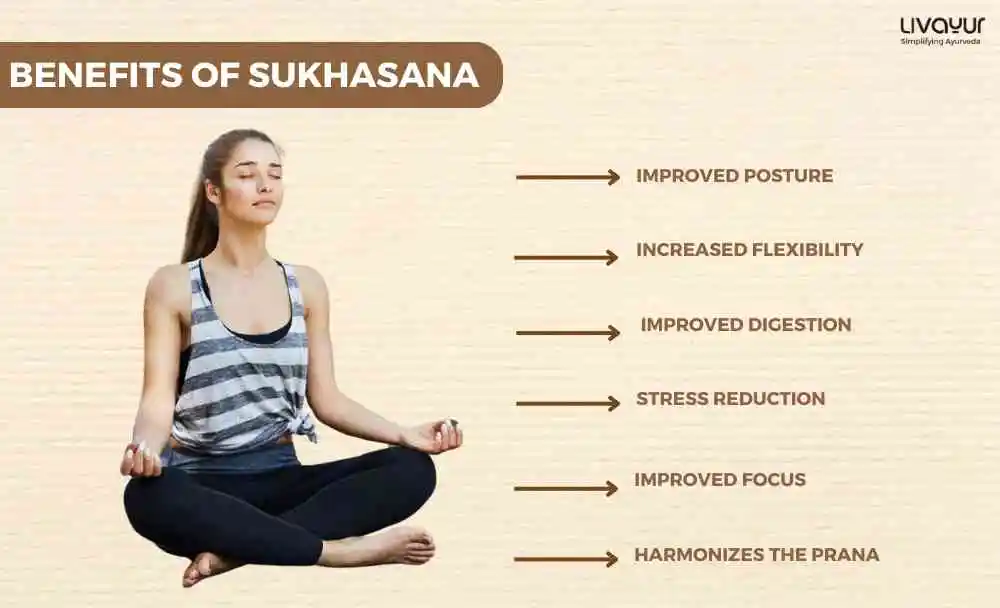
This article is reviewed by an expert
Sukhasana, also known as Easy Pose or the “Pose of Comfort,” is a popular yoga asana practised for its numerous physical, mental, and spiritual benefits. This simple cross-legged seated pose is accessible to practitioners of all levels and can be performed anywhere, making it a versatile and effective practice. In this article, we will explore the benefits of Sukhasana, learn how to perform it correctly step by step and address some frequently asked questions from an Ayurvedic perspective.
Benefits of Sukhasana [1] [2]
Physical Benefits
a) Improved Posture:
- Primary benefit: Sukhasana helps align the spine, promoting good posture and reducing strain on the back and neck. It encourages the natural curvature of the spine, maintaining its optimal alignment.
- Secondary benefit: By strengthening the back and core muscles, Sukhasana enhances stability and reduces the risk of back pain and discomfort.
b) Increased Flexibility:
- Primary benefit: Regular practice of Sukhasana improves hip and knee flexibility, making other yoga poses more accessible. It gently stretches the hip joints and increases the range of motion.
- Secondary benefit: Sukhasana relieves tension in the hips and lower back, promoting greater comfort and ease of movement throughout the day.
c) Improved Digestion:
- Primary benefit: The gentle compression in Sukhasana stimulates the digestive organs, aiding digestion and reducing bloating. It encourages the smooth flow of energy in the abdominal region.
- Secondary benefit: Sukhasana enhances blood circulation to the abdominal area, supporting optimal digestive function and alleviating discomfort associated with digestive issues.
Mental Benefits
a) Stress Reduction:
- Primary benefit: Sukhasana promotes relaxation and calms the mind, reducing anxiety and stress levels. It encourages a state of mental and emotional balance and tranquillity.
- Secondary benefit: By releasing tension and promoting a sense of well-being, Sukhasana helps in managing stress-related symptoms such as insomnia and fatigue.
b) Improved Focus and Concentration:
- Primary benefit: The seated position and mindful breathing in Sukhasana improve focus and concentration. It creates a stable and grounded foundation for mental clarity.
- Secondary benefit: Sukhasana reduces mental fatigue, enhances cognitive function, and improves productivity by cultivating a calm and focused state of mind.
c) Balancing Energy Flow:
- Primary benefit: Sukhasana helps balance the energy centres in the body, harmonizing the flow of vital energy or prana. It supports overall well-being and vitality.
- Secondary benefit: By promoting the smooth flow of prana, Sukhasana enhances the body’s natural healing mechanisms, promoting self-renewal and rejuvenation.
How to Perform Sukhasana Step by Step [2]

Follow these step-by-step instructions to practice Sukhasana correctly:
- Find a quiet and comfortable space. Sit on a yoga mat or a cushion.
- Extend your legs in front of you and gently cross them at the shins, bringing each foot beneath the opposite knee.
- Rest your hands on your knees or thighs, palms facing downward.
- Lengthen your spine, keeping the back straight and the shoulders relaxed.
- Close your eyes or soften your gaze, allowing your breath to flow naturally.
- Stay in this position for 5-10 minutes or longer, focusing on your breath and maintaining a sense of ease.
Conclusion
In conclusion, Sukhasana, also known as the Easy Pose or the Pose of Comfort, is a beneficial yoga asana that promotes relaxation, mindfulness, and overall well-being. By practicing Sukhasana regularly, you can experience improved physical flexibility, enhanced mental clarity, and a deeper connection with your inner self.
Sukhasana offers primary benefits such as improved posture, increased hip flexibility, and reduced stress. Secondary benefits include enhanced relaxation, better digestion, and improved focus. It is a beginner-friendly pose that can be adapted to individual needs and practiced by individuals of all fitness levels.
Remember to approach Sukhasana with patience and listen to your body, making necessary modifications to ensure comfort and safety. If you have any pre-existing medical conditions or concerns, consult with a healthcare professional or a qualified yoga instructor before incorporating Sukhasana or any other yoga asana into your routine.
FAQs
Can individuals with knee or hip injuries practice Sukhasana?
Sukhasana is generally safe for individuals with knee or hip injuries. However, it is advisable to consult with a qualified yoga teacher or healthcare professional before practising if you have any specific concerns. Modifications and props can be used to support comfort and alignment.
Can Sukhasana be practised during pregnancy?
Sukhasana is considered safe during pregnancy, especially during the early stages[1]. However, it is recommended to consult with a prenatal yoga instructor or healthcare provider for personalized guidance. Modifications may be necessary to ensure the comfort and safety of the mother and baby.
How long should one practice Sukhasana?
Sukhasana can be practised for a duration that suits your comfort and schedule. Starting with a few minutes and gradually increasing the duration is recommended. Aim for at least 5-10 minutes per session to experience its benefits fully.
Can Sukhasana be practised for meditation?
Absolutely! Sukhasana is an ideal pose for meditation due to its comfortable seated position and the natural alignment of the spine. It allows the body to relax while maintaining an alert and focused mind, creating a conducive environment for meditation practice.
Can Sukhasana help with back pain?
Yes, Sukhasana can be beneficial for individuals experiencing mild to moderate back pain. However, it is contraindicated for individuals with moderate to severe lower back pain as such individuals tend to slouch when in the pose and this is contrary to the purpose of the asana [3].
Disclaimer: The information provided here is for general information and not meant to substitute any medical advice. Please consult your doctor for appropriate medical consultation.
References:
- https://www.researchgate.net/profile/Dr-T-Reddy/publication/340731445_Benefit_of_Yoga_Poses_for_Women_during_Pregnancy/links/5e9ad32592851c2f52aa9bcb/Benefit-of-Yoga-Poses-for-Women-during-Pregnancy.pdf
- https://www.theyogicjournal.com/pdf/2018/vol3issue1/PartH/3-1-63-999.pdf
- https://www.mdpi.com/1660-4601/17/13/4621




















